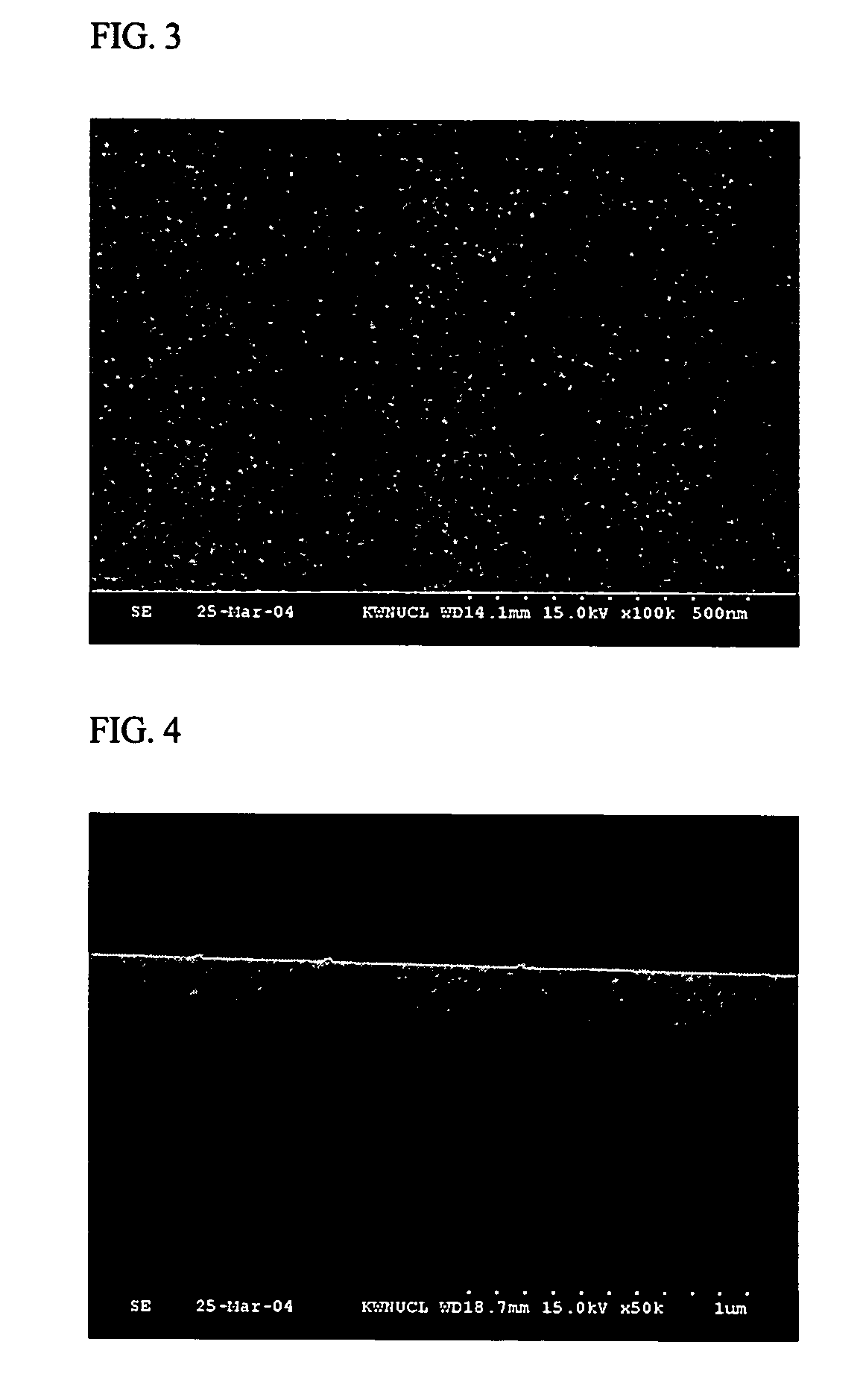Method for improvement of performance of si thin film anode for lithium rechargeable battery
a lithium rechargeable battery and thin film anode technology, which is applied in the manufacture of electrodes, cell components, cable/conductor components, etc., can solve the problems of poor charge/discharge cycle characteristics, mechanical and electrical degradation, and capacity decline, so as to improve the charge/discharge cycle characteristics of lithium secondary batteries, improve the problem of electrical contact loss, and improve the effect of battery charge/discharge cycle characteristics
- Summary
- Abstract
- Description
- Claims
- Application Information
AI Technical Summary
Benefits of technology
Problems solved by technology
Method used
Image
Examples
example 1
[0051] FeCl3 was mixed to a final concentration of 0.4 M in an aqueous 2.4 M HCl solution to prepare an etching solution that was then used in surface treatment by etching the surface of a Ni foil for about 1 min. On the surface treated-Ni foil current collector, a Si thin film of 5000 Å thickness was formed from a Si target having a diameter of 2″ (99.99%) by R.F. magnetron sputtering. Sputtering was performed in a chamber which had been vacuum pumped to 2×10−6 Torr and then set to 5 mTorr by injection of argon gas.
[0052] In order to confirm electrochemical properties of the Si thin film electrode, two #2016 coin cell batteries were prepared using a pure Li foil as a cathode, and a mixed solution in which 1M LiPF6 was added to a mixed solvent of ethylene carbonate (EC) and diethylene carbonate (DEC) (volume ratio 1:1), as an electrolyte solution. These cell batteries were assembled in a globe box under argon atmosphere, and were then subjected to more than 30 charge / discharge expe...
example 2
[0053] In order to confirm effects due to application of bias voltage during sputtering, the following experiments were performed: Experiment A; vapor-deposition of a Si thin film on a Si-wafer by sputtering, and Experiment B; vapor-deposition of the Si thin film on the Si-wafer by sputtering while applying DC bias voltage of −100 V.
[0054]FIGS. 1 and 2 show SEMs of the surface (FIG. 1) and vertical cross-section (FIG. 2) of the Si thin film obtained in Experiment A, respectively. FIGS. 3 and 4 show SEMs of the surface (FIG. 3) and vertical cross-section (FIG. 4) of the Si thin film obtained in Experiment B, respectively.
[0055] The Si thin film in Experiment A revealed a columnar structure having rough surface morphology and cross section, while the Si thin film in Experiment B revealed a smoother vapor-deposition surface due to application of bias voltage.
[0056] These Si thin films were subjected to charge / discharge experiments as in Example 1. FIG. 5 shows an SEM of the surface ...
example 3
[0057] Instead of a Ni foil, a Cu foil was surface-treated using the same procedure as in Example 1, and the experiment was repeated by applying DC bias voltage of −100 V using the same procedure as in Example 2.
[0058]FIG. 9 shows an SEM of the surface of the etched Cu foil, and FIG. 13 is a graph showing charge / discharge cycle characteristics of the battery fabricated using this Cu foil.
PUM
| Property | Measurement | Unit |
|---|---|---|
| depth | aaaaa | aaaaa |
| size | aaaaa | aaaaa |
| temperature | aaaaa | aaaaa |
Abstract
Description
Claims
Application Information
 Login to View More
Login to View More - R&D
- Intellectual Property
- Life Sciences
- Materials
- Tech Scout
- Unparalleled Data Quality
- Higher Quality Content
- 60% Fewer Hallucinations
Browse by: Latest US Patents, China's latest patents, Technical Efficacy Thesaurus, Application Domain, Technology Topic, Popular Technical Reports.
© 2025 PatSnap. All rights reserved.Legal|Privacy policy|Modern Slavery Act Transparency Statement|Sitemap|About US| Contact US: help@patsnap.com



